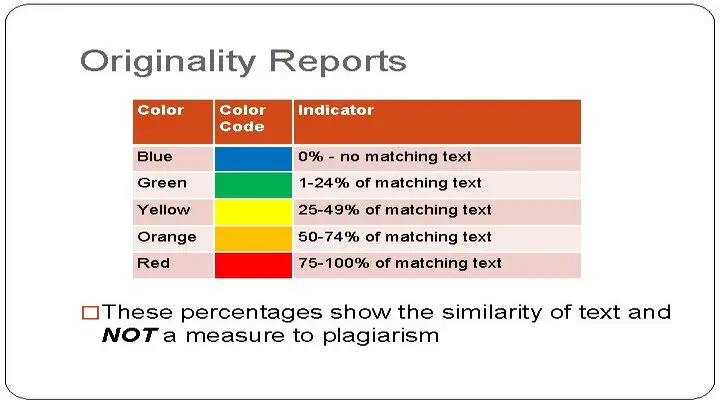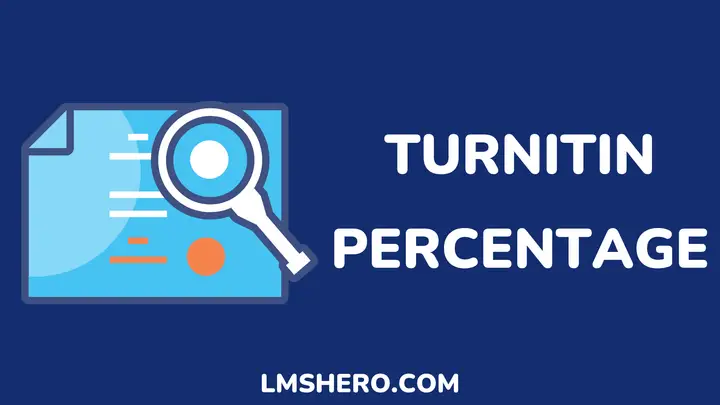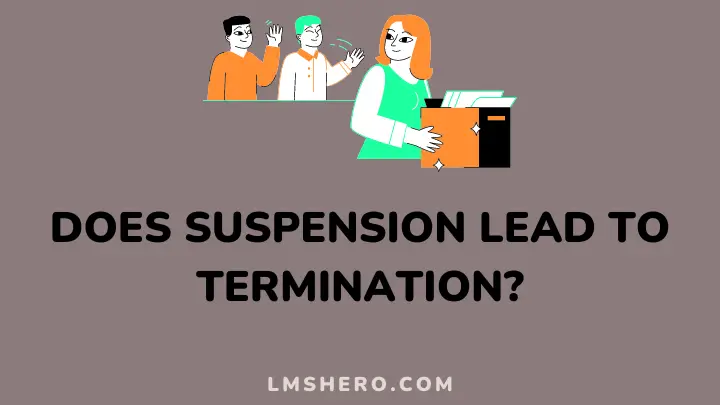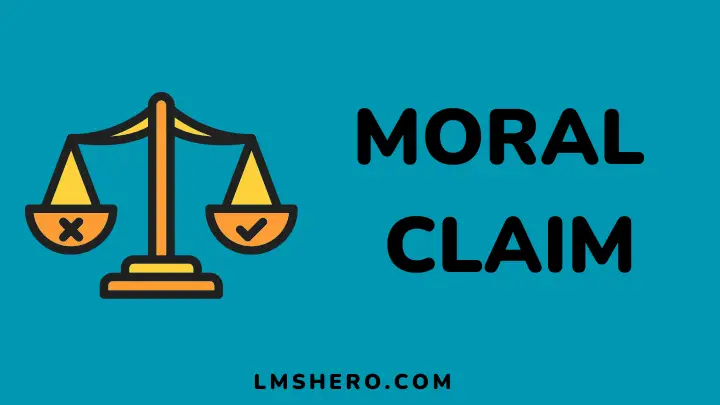Perhaps you just ran your assignment through Turnitin to check for plagiarism and the result indicates a certain percentage but you don’t even know what that means, then you should read this article.
Whether you’re writing an essay or thesis, it is important to know the acceptable Turnitin percentage or similarity index. This is to avoid getting your work rejected or getting a low grade.
Turnitin percentage tells you the amount of matching or similar text present in your work on a scale of 0 to 100% (0 being the least and 100% being the highest).
In short, it detects if you copied someone’s work closely or verbatim. However, there’s more to plagiarism than matching text.
Learn what a good similarity score is as well as other factors instructors consider when determining plagiarism in this article.
What is the acceptable Turnitin percentage?

While there is no universally specified Turnitin percentage, a similarity index of 10% and below is okay and widely accepted. However, different universities and colleges have their own reference and citation guidelines.
The acceptable Turnitin percentage also varies by course of study. For instance, law students may be allowed 40% to 60% of references for certain assignments because certain legislations or case materials cannot be rephrased without changing their entire meaning.
The percentage also varies for each academic degree level. For instance, a master’s thesis may allow up to 20% plagiarism because the paper heavily depends on citing existing authorities.
Whereas a doctorate original dissertation should have less than 10% reference. In fact, Ph.D. students would be required to synthesize materials to produce 100% original content in case of dissertations.
If we also consider the type of paper, the acceptable percentage for essays like literature is 5% and below. Acceptable publication manuscripts must be within 5-7% of referencing also.
What does the Similarity Index percentage indicate?
| Color | Meaning |
| Blue (no matching text) | This means that the paper is free of any similar text, references, or citations. In the academic field, this is a big red flag. Every student’s work is supposed to contain some amount of reference or citation from relevant sources. The absence of this could also mean that a large percentage of your work is paraphrased. |
| Green (1% – 24% matching text) | Green signifies 1% to 24% of similar text in your work. This is within range of the acceptable Turnitin percentage. However, your work may still be plagiarized if you fail to reference rightly. |
| Yellow (25% – 49% matching text) | Yellow says that your work contains 25% to 49% of plagiarism which is definitely too much. In rare cases and situations, students may be allowed to have citations within these ranges but most often it is a bad percentage. |
| Orange (50% – 74% matching text) | A Turnitin percentage of 50% to 74% shows orange. Obviously the shows poor academic writing with lots of plagiarism. |
| Red (75% – 100% matching text) | Red depicts the highest level of plagiarism in your work. |
Is plagiarism good?
Although plagiarism is unethical, having a decent amount of matching text in your work proves that it is well-researched and links to other sources. So, yes, the right amount of plagiarism is good.
Failure to have a few matching texts in your work means that you didn’t use any reference or any other source in your work which is not possible.
So, a similarity index of 1% to 10% is okay except in unavoidable cases when the names of books, government bodies, and organizations may increase the score significantly.
Difference between similarity and plagiarism
To be clear, Turnitin doesn’t scan for plagiarism, rather it scans for matching text. Plagiarism is actually determined by your instructor.
Plagiarism is the act of taking someone else’s work and passing them as your own and that depends on many factors of which the similarity index is one.
Having a high percentage of similarity score may not necessarily be counted as plagiarism. Instructors use the highlight of matching text in your work as an investigative tool to determine if the match is acceptable or not.
If the sources in your work are attributed and quoted rightly, then that isn’t considered plagiarism. However, you shouldn’t have too many references in your work, so your own ideas can shine through.
A good research paper shouldn’t contain more than 45 references. Systematic reviews could have as many as 49 references but a good case study doesn’t need more than 29 references.
What causes plagiarism?
Since a high Turnitin percentage doesn’t necessarily translate into plagiarism, what factors then determine plagiarism?
Here are some of the reasons why your work may be flagged for plagiarism:
1. Not crediting the source
This is the first and major cause of plagiarism. Refusing to reference other people’s ideas in your work is in fact an academic crime. It is interpreted as claiming ownership of someone else’s work.
One mistake students make is thinking that by paraphrasing they would not have to quote or acknowledge a source. Conversely, even if you put an idea from a particular source in your own words, you still have to reference it to avoid plagiarism.
2. Paraphrasing too closely
Another thing that can contribute to plagiarism is by using almost the same word as the source, even after referencing the source.
So, instead of changing a few words or the order of the original words of the author, write yours in completely different words. Better still, you could use the exact words from the source but make sure that you quote the text.
3. Using statistics without reference
If you’re using statistics, charts, and tables in your work, it is important that you credit the owner else you’d be guilty of plagiarism. By citing the source of your statistics, table, or chart you can support your claim and strengthen your argument.
Keep in mind that the most reliable statistics come from government reports, scholarly journal articles, conference papers, and the like.
4. Using images without citing the sources
As surprising as it may seem, attaching an image you got online in your work without citing the author counts as plagiarism. Any image downloaded online has a creator who deserves credit for their work.
Additionally, if you use a photograph taken by you, it is best that you cite yourself as the creator so your instructor can know where the image is coming from.
5. Copying or buying someone else’s paper
Outsourcing your research work to someone else or lifting an already published work from the net is a grievous academic crime. By hiring someone to write your research paperwork, you risk having a large part of your work plagiarized.
If you also take someone else’s work from the net or copy a large part of it, you can be sure that your work will contain a high similarity score.
The punishment for such academic misconduct could be harsh. As such, I will advise that you work hard to ensure originality in your work by all means.
6. Padding your bibliography or reference list
This means compiling a fake list of bibliography or references to show that you have researched when you haven’t. As a result, the paper will highlight a lot of bibliographies or references not related to the work.
Students could be charged with gross academic misconduct which could lead to serious consequences. So, it’s important that you painstakingly highlight a bibliography that pertains to your work.
FAQs
What Turnitin percentage is too high?
If your work has a matching text that’s above 25%, that’s a really high Turnitin percentage. This could be the result of copying another person’s work word for word, a lengthy bibliography, or direct citations.
What does a Turnitin percentage of 100% mean?
A similarity score of 100% means that Turnitin found a 100% matching text to your work in its database.
What does a 50% Turnitin score mean?
A similarity score of 50% means that half of your work has a matching text to another source in the Turnitin database.
Is a 1% Turnitin score good?
Yes, it is.
However, a score of 1% may be suspectable, because it may mean that you didn’t reference all your source and a good research paper should have at least a 5% similar index.
Final Thoughts
Plagiarism is unethical and can result in disciplinary action from your institution so you want to avoid it at all costs. By running your work through Turnitin, you can get to reduce the percentage of matching texts in your work.
Although Turnitin can help with plagiarism, keep in mind that it doesn’t detect plagiarism. So, it is best that you read this article to know the factors that cause plagiarism and avoid them.
Lastly, you should read the article on the differences between an academic GPA and a total GPA.
I hope this article helped. Thanks for reading.






